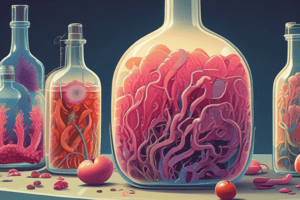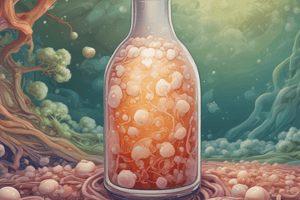Podcast
Questions and Answers
Match the following terms with their definitions:
Match the following terms with their definitions:
Amylase = An enzyme that breaks down starch into sugar Zymase = A term used to refer to a single enzyme responsible for fermentation Glycolysis = The process of breaking down sugars to carbon dioxide Fermentation = The process of yeast cells breaking down sugars for energy
Match the following statements with their corresponding facts:
Match the following statements with their corresponding facts:
15 trillion yeast cells are in one pound of compressed yeast = Yeast cells are very small Yeast uses energy for survival and reproduction = Yeast cells break down sugars for energy Alcohol evaporates to a gas and expands during baking = Fermentation produces as much alcohol as it does carbon dioxide Malted barley flour is used to add amylase in lean doughs = Yeast lacks amylase and cannot break down starch into sugar
Match the following processes with their descriptions:
Match the following processes with their descriptions:
Fermentation = The process of yeast cells breaking down sugars for energy Glycolysis = The breakdown of starch into sugar Budding = The process of yeast cell reproduction Baking = The process of breaking down sugars to carbon dioxide
Match the following elements with their roles:
Match the following elements with their roles:
Match the following terms with their characteristics:
Match the following terms with their characteristics:
Match the following statements with their corresponding results:
Match the following statements with their corresponding results:
Match the following processes with their importance:
Match the following processes with their importance:
Match the following elements with their relationships:
Match the following elements with their relationships:
Match the factors that affect yeast fermentation with their effects:
Match the factors that affect yeast fermentation with their effects:
Match the type of yeast with its primary characteristic:
Match the type of yeast with its primary characteristic:
Match the sugar types with their fermentation rates:
Match the sugar types with their fermentation rates:
Match the type of yeast with its recommended usage:
Match the type of yeast with its recommended usage:
Match the effects of yeast fermentation with their descriptions:
Match the effects of yeast fermentation with their descriptions:
Match the type of yeast with its production process:
Match the type of yeast with its production process:
Match the yeast-related terms with their descriptions:
Match the yeast-related terms with their descriptions:
Match the factors that slow yeast fermentation with their effects:
Match the factors that slow yeast fermentation with their effects:
Match the type of yeast with its shelf life:
Match the type of yeast with its shelf life:
Match the type of yeast with its usage ratio:
Match the type of yeast with its usage ratio:
Match the yeast fermentation outcomes with their characteristics:
Match the yeast fermentation outcomes with their characteristics:
Match the type of yeast with its desirable temperature range:
Match the type of yeast with its desirable temperature range:
Match the yeast amounts with their effects:
Match the yeast amounts with their effects:
Match the type of yeast with its specific use case:
Match the type of yeast with its specific use case:
Match the dough conditions with their effects on yeast fermentation:
Match the dough conditions with their effects on yeast fermentation:
Match the type of yeast with its unique characteristic:
Match the type of yeast with its unique characteristic:
Match the yeast products with their characteristics:
Match the yeast products with their characteristics:
Match the baking practices with their effects on yeast fermentation:
Match the baking practices with their effects on yeast fermentation:
Match the following types of yeast with their characteristics:
Match the following types of yeast with their characteristics:
Match the following yeast strains with their suitable environments:
Match the following yeast strains with their suitable environments:
Match the following attributes with their corresponding yeast forms:
Match the following attributes with their corresponding yeast forms:
Match the following yeast storage methods with their corresponding shelf life:
Match the following yeast storage methods with their corresponding shelf life:
Match the following yeast characteristics with their potential issues:
Match the following yeast characteristics with their potential issues:
Match the following sourdough bread characteristics with their countries of origin:
Match the following sourdough bread characteristics with their countries of origin:
Match the following sourdough starter preparation methods with their ingredients:
Match the following sourdough starter preparation methods with their ingredients:
Match the following yeast handling methods with their benefits:
Match the following yeast handling methods with their benefits:
Match the following bread-making techniques with their characteristics:
Match the following bread-making techniques with their characteristics:
Match the following yeast-related terms with their definitions:
Match the following yeast-related terms with their definitions:
Flashcards are hidden until you start studying
Study Notes
Yeast Fermentation
- Yeast fermentation is a process in which yeast cells break down sugars for energy, producing carbon dioxide and alcohol as byproducts.
- Yeast uses the energy for survival and reproduction.
- The rate of yeast fermentation is affected by several factors, including temperature, amount of salt, amount of sugar, type of sugar, pH of dough, presence of antimicrobial agents, and amount of yeast.
Yeast Cells
- Yeast cells are very small, single-celled microorganisms, with approximately 15 trillion cells in one pound of compressed yeast.
- Yeast cells reproduce by budding, and visible scars from previous buddings can be seen on the yeast cell.
Enzymes and Fermentation
- Yeast can be thought of as tiny enzyme machines, breaking sugars into smaller and simpler molecules with every step.
- Yeast lacks amylase and cannot break down starch into sugar, which is why amylase is an important additive in bread baking.
- The overall process of fermentation involves multiple steps, controlled by separate enzymes, and produces carbon dioxide, alcohol, and small amounts of flavor molecules.
Factors Affecting Yeast Fermentation
- Temperature: Yeast is dormant at 32–34°F (0–1°C), active at 50°F (10°C), and slows down at 120°F (50°C), with an optimal temperature of 78–82°F (25–28°C).
- Amount of salt: Salt retards yeast fermentation, and the optimal amount of salt is 1.8–2.5% (baker's percentage).
- Amount of sugar: Small amounts of sugar (up to 5%) increase yeast activity, while large amounts (above 10%) slow fermentation.
- Type of sugar: Sucrose, glucose, and fructose are fermented rapidly, maltose is fermented slowly, and lactose is not fermented at all.
- pH of dough: The optimal pH for yeast fermentation is an acidic 4 to 6.
- Presence of antimicrobial agents: Certain antimicrobial agents slow or stop yeast fermentation.
- Amount of yeast: The more yeast, the faster the fermentation, but excessive yeast can add an undesirable yeasty flavor and exhaust dough of sugars.
Types of Yeast
- Compressed yeast: Fresh, moist cakes or blocks with 30% yeast and 70% moisture, lasts up to two weeks when stored wrapped in plastic and refrigerated, and three to four months when frozen.
- Active dry yeast: Dried granules with less than 10% moisture, sold in vacuum-packed jars or pouches, and lasts several months at room temperature, longer if frozen or refrigerated.
- Instant yeast: Developed in the 1970s, instant yeast can be added directly to dough without first hydrating in water, and is more vigorous than compressed or active dry yeast.
Sourdough Starters
- Sourdough starters are prepared by mixing flour and water, allowing wild yeast and lactobacilli bacteria to ferment, and can be used to leaven bread.
- Fresh starter does not need to be made for each new day's production, and can be saved for the next day's bread by mixing it with fresh flour and water.
- Some bakeshops pride themselves on the number of years they have continued to bake from their original starter.
Studying That Suits You
Use AI to generate personalized quizzes and flashcards to suit your learning preferences.




